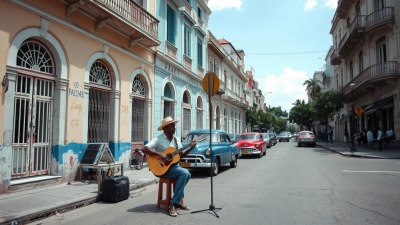Street Music and Survival in Havana
Explore the vibrant street music scene in Havana and its role in survival and cultural identity.

Image created with Flux Schnell
The vibrant streets of Havana are alive with the sound of music, a melody that intertwines with the very fabric of life in the city. For many residents, street music is not just a source of entertainment; it is an essential part of their survival and cultural identity. The rhythms resonate through the alleys, plazas, and sidewalks, creating a symphony that embodies the resilience and creativity of the Cuban people.
The Historical Context of Music in Cuba
Cuban music has a rich history that reflects the diverse influences that have shaped the island. From African drumming traditions to Spanish guitar melodies, the fusion of styles has given birth to genres such as son, rumba, salsa, and more recently, reggaeton. Each form of music tells a story—of colonialism, slavery, revolution, and the ongoing struggle for identity. By understanding this context, we can appreciate how street music serves as a powerful medium for expression in contemporary Havana.
The Role of Street Musicians
Street musicians in Havana, known as 'trovadores' and 'soneros,' play a vital role in the local economy and community. With limited job opportunities and income sources, many turn to music as a means of livelihood. Armed with nothing but their instruments, they perform in busy tourist areas, ensuring their music reaches both locals and visitors alike. Their passion and dedication breathe life into the streets, as they draw crowds who are eager to dance, sing along, or simply enjoy the atmosphere.
Making a Living Through Music
For many musicians, performing on the streets is about survival. In a city where state salaries often do not suffice, tips from passersby become a crucial source of income. Street performances can vary from traditional son ensembles to lively salsa bands, capturing the attention of tourists and encouraging them to contribute to the musicians' earnings. In this way, music transcends mere entertainment; it transforms into a vital economic lifeline.
Community and Connection
Havana’s street music also fosters a sense of community. Musicians often collaborate, sharing ideas and influences as they interact with one another. The impromptu nature of street performances allows for creativity to flourish, as musicians adapt their songs in real-time, responding to their audience's mood and energy. This communal aspect reflects the broader culture of solidarity and support that characterizes Havana's neighborhoods, where people rely on one another in tough times.
The Influence of Tourism
The influx of tourists in Havana has both positive and negative effects on street music. On one hand, tourism provides musicians with an audience and an opportunity to showcase their talent beyond local limits. The financial benefits of performing for tourists can lead to a better quality of life for some musicians. On the other hand, the commercial pressure to cater to tourist expectations can dilute the authenticity of the music. Some artists may feel compelled to modify their performances to appeal to foreign tastes, risking the loss of unique cultural expressions.
Struggles and Challenges
Despite the vibrancy of Havana's street music scene, musicians face numerous challenges. Economic hardships, restrictive regulations, and the threat of eviction from public spaces pose significant obstacles. The struggle to find a conducive environment to perform often leads to tensions between musicians and law enforcement. Additionally, the recent changes in Cuba's economy and policies can create uncertainty for those who rely on music as a primary source of income. Musicians must navigate these complexities while remaining hopeful and determined to continue their art.
Government Policies and Legal Framework
The Cuban government has implemented various policies regarding artistic expression, which directly impact musicians. While some regulations aim to promote cultural heritage and protect artists, they can also impose limitations on public performances. Recent reforms have opened new avenues for self-employment, but the bureaucratic processes can be cumbersome and challenging to navigate. Many musicians advocate for more supportive policies that recognize their contributions to culture and the economy.
The Impact of Technology
The rise of technology has significantly changed how street musicians create and distribute their music. Social media platforms provide opportunities for exposure beyond Havana, enabling artists to share their performances with a global audience. Many musicians utilize these platforms to connect with fans, sell their music, and even crowd-fund their projects. However, limited access to the internet in Cuba can be a hindrance, as not all musicians can take full advantage of digital marketing and distribution.
Preserving Cultural Heritage
The street music scene in Havana plays a crucial role in the preservation of Cuban cultural heritage. By sharing traditional songs and styles, musicians pass their knowledge down through generations. Initiatives that promote music education outside formal institutions are essential for fostering young talent and ensuring that traditional forms continue to thrive. Community workshops and informal gatherings provide spaces for musicians to learn from one another and hone their crafts.
Street Music as a Reflection of Life
In many ways, the street music scene in Havana serves as a mirror reflecting the complexities of life on the island. The music encompasses themes of love, struggle, joy, and resilience, resonating with both the highs and lows of existence. Every note played has a story to tell, embodying the spirit of the Cuban people and their enduring hope for a better future. Musicians express their realities through their art, and in doing so, they create a profound connection with their audience—local and international.
A Source of Inspiration
Street music not only entertains but also inspires. Many who encounter Havana’s musicians leave changed by the experience, moved by the passion and authenticity present in every performance. Whether they are locals absorbing the music of their culture or tourists discovering its richness for the first time, the power of street music transcends language barriers. It creates a shared emotional experience, fostering understanding and appreciation for the Cuban way of life.
Future of Street Music in Havana
As Havana continues to evolve, the future of its street music scene remains dynamic and full of possibilities. Ongoing support for musicians, both from local communities and the government, is crucial. The resilience and adaptability of Havana's musicians will ensure that music continues to thrive, despite challenges. As they navigate the changing landscape, musicians will blend tradition with innovation, keeping their art relevant while honoring their roots.
The street music scene in Havana is much more than a form of entertainment; it is a vital thread in the tapestry of Cuban culture and survival. It provides a means for artists to sustain themselves, fosters community connections, and preserves a rich heritage. As we celebrate the vibrancy of Havana’s streets, we recognize music as a fundamental part of what it means to be human—a reflection of our struggles, hopes, and dreams.











